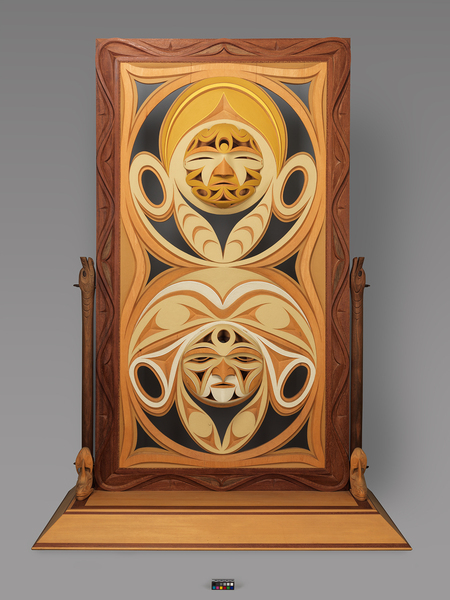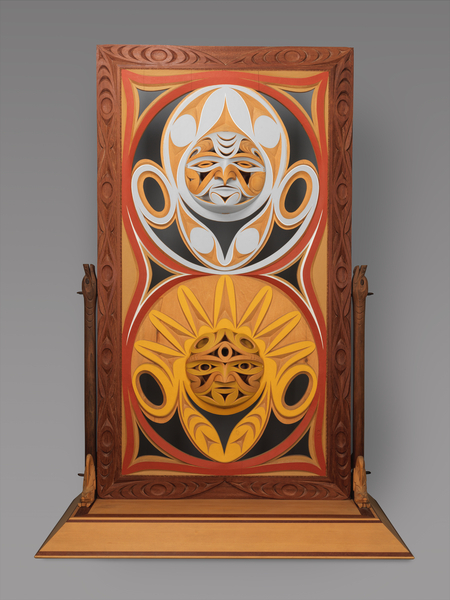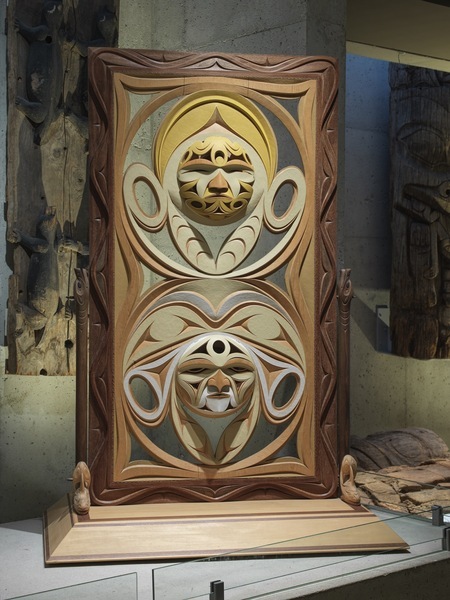e'ehhwe'p sywth (To Share History) Item Number: 3113/1 a-f from the MOA: University of British Columbia




Description
Tall, double-sided, three-dimensionally carved vertical panel on stand. Killer whale and crocodile themes; one side is inspired by coastal Salish themes/imagery, the other side is inspired by Sepik River (Papua New Guinea) themes and imagery. Made of yellow cedar, walnut and rosewood, with ebony inlay.
Narrative
Marston wrote: "For me this carving is a symbol of connection between different cultures. Our patience and understanding for one another. Our willingness to help, and our kindness in sharing tradition. Ehwep Syuth also reflects the value of taking time to look deeper, to truly understand people." Marston is featured in a documentary with artist Teddy Balangu, called "Killerwhale and Crocodile." The documentary is a visual tale of Marston’s journey to the Sepik River, Papua New Guinea and Balangu's journey to Salish territory, in Canada. The film tells the story of their meeting and cross-cultural exchange. During Marston’s 29-day-journey to Papua New Guinea, the two carvers were able to learn from the unique traditions that influence each artist’s work. Balangu then travelled to Canada with Marston, where he worked as the artist-in-residence at the Museum of Anthropology at UBC, for about five-and-a-half months.
Iconographic Meaning
From the artist's statement: "...the suns and the moons on either side are placed in opposing positions; this symbolizes the two cultures that are geographically a world apart but similar in so many ways. Four face masks carved from New Guinea rosewood are placed beneath the exterior yellow cedar suns and moons and can only be viewed while looking in through the negative space that has been removed. This is the embodiment of the people found within the diverse cultures. Two on either side symbolizing the balance of male and female resonates to the importance of balance in ceremony. The supporting posts carved from black walnut are Sea Wolves, the guardians of land and water. The pins that support the stance of the centre panel are carved from ebony in the shapes of snakes and salmon. The carved rosewood border symbolizes the connection we have with water and also the connection to the forest. ...Also within the border sections of design are inlayed with black walnut in four areas. This represents the four directions, which is an important part of our ceremonial life. The influence of Papua New Guinea helped distinguish colours; these brighter pigments are direct tones found within the land. The Killer Whales and Crocodiles at the base of the posts are reinforcements. They are supporting one another and have become brothers, also reflecting the role these creatures play in both nations' historical legends. The fine braided cedar bark rope symbolizes the connection and ties that have bound the cultures together... The design of the panel depicts many different animals found in Papua New Guinea and Canada. These sacred animals are found within positive and negative space. The head, eye and mouth may appear in negative space, while the wings flow off these lines into positive. Colours change, but forms continue to stay together."
Cultural Context
Contemporary art.
Item History
- Made by John Marston (Maker) in Vancouver Island, British Columbia, Canada during 2007
- Owned by Christiane Smyth and George Smyth before June 12, 2015
- Received from Christiane Smyth (Donor) and George Smyth (Donor) on June 12, 2015
What
- Name
- e'ehhwe'p sywth (To Share History)
- Identification Number
- 3113/1 a-f
- Type of Item
- panel
- Material
- yellow cedar wood, sepik rose wood, black walnut wood, ebony wood, cedar bark and paint
- Overall
- height 213.5 cm, width 149.5 cm, depth 88.3 cm
Who
- Culture
- Coast Salish: Stz'uminus
- Creator
- John Marston (Maker)
- Previous Owner
- Christiane Smyth and George Smyth
- Received from
- Christiane Smyth (Donor) and George Smyth (Donor)
Where
- Holding Institution
- MOA: University of British Columbia
- Made in
- Vancouver Island, British Columbia, Canada
When
- Creation Date
- during 2007
- Ownership Date
- before June 12, 2015
- Acquisition Date
- on June 12, 2015
Other
- Item Classes
- carvings & sculpture
- Condition
- good
- Current Location
- Case 4
- Accession Number
- 3113/0001 a-f